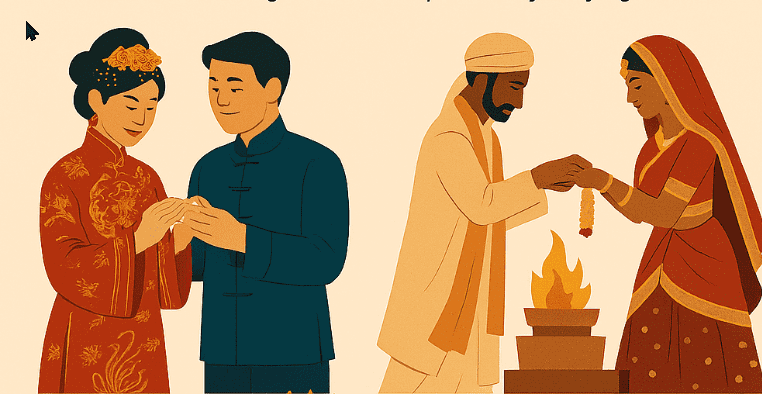
The Cultural Tapestry of Marriage
Weddings are among the most meaningful and festive occasions in any culture. Beyond the white dresses and wedding rings lies a rich diversity of cultural wedding traditions that honor love, family, and community. From ancient rituals to modern adaptations, each custom tells a story about values, history, and hopes for the future.
Weddings are more than unions—they’re cultural expressions of joy, tradition, and identity. Explore the unique rituals that define marriage ceremonies across the globe.
1. India: The Sacred Fire and Saptapadi
Indian weddings are multi-day affairs filled with color, music, and spiritual significance. Central to Hindu weddings is the Saptapadi, where the couple takes seven steps around a sacred fire, each representing a shared marital vow. The ceremony often includes Mehendi (henna) nights and Baraat processions with dancing and drumming.
Weddings are as much about two individuals as they are about uniting families and honoring ancient customs.
2. Japan: The San-San-Kudo Ceremony
In traditional Shinto weddings, the San-San-Kudo or “three-three-nine times” ritual involves the bride and groom taking three sips each from three sacred sake cups. The act symbolizes unity and the bonding of two families.
Shinto ceremonies are minimalist and deeply spiritual, often held in shrines adorned with natural elements and symbolic offerings.
3. Mexico: El Lazo and the Coin Ceremony
Mexican weddings blend Catholic and indigenous elements. During the ceremony, a lazo (a floral or beaded rope) is placed in a figure-eight shape around the couple, symbolizing eternal unity. In the arras ritual, the groom gives the bride 13 gold coins representing trust and shared prosperity.
Music, vibrant colors, and family-centered celebrations define these spirited ceremonies.
4. Nigeria: Traditional Attire and Community Blessings
Nigerian weddings, especially among the Yoruba and Igbo tribes, are dynamic affairs filled with dance, prayer, and symbolism. The bride often wears intricately patterned fabrics, beads, and a gele (head wrap), while the groom dons a matching agbada robe. Ceremonies feature blessings from elders and a symbolic wine-sharing ritual.
The wedding often serves as a communal event, involving extended families and local traditions.
5. China: The Tea Ceremony and Red Symbolism
Red is the color of joy in Chinese culture, and it’s central to traditional weddings—from attire to decorations. A highlight is the tea ceremony, where the couple serves tea to their elders as a sign of respect and receives blessings and gifts in return.
Symbolic practices like hair-combing and door games add both fun and meaning to the wedding journey.
6. Jewish Weddings: Chuppah and Breaking the Glass
Jewish weddings are rich with ritual. The couple marries under a chuppah, a canopy that symbolizes the home they will build together. The ceremony includes the reading of the ketubah (marriage contract) and the famous breaking of the glass, signifying both the joy and fragility of life.
Guests shout “Mazel Tov!” to mark the celebratory moment.
7. South Korea: Ducks and Wooden Geese
In traditional Korean weddings, the groom presents the bride’s family with a pair of wooden geese or ducks, symbols of fidelity and harmony. The paebaek ceremony includes bowing to elders, offering tea, and catching dates and chestnuts symbolizing fertility.
Modern weddings often combine traditional and Western elements in elegant harmony.
8. Scotland: Handfasting and Lucky Charms
Scottish weddings may include handfasting, an ancient Celtic ritual in which the couple’s hands are tied together to symbolize unity. Kilts, bagpipes, and traditional toasts are also hallmarks of Scottish nuptials.
Some brides tuck a silver coin in their shoe or wear a sixpence for luck and prosperity.
9. Morocco: Henna Night and Bridal Preparation
Moroccan weddings are vibrant multi-day affairs. A special event is the henna night, where the bride’s hands and feet are adorned with intricate designs symbolizing joy, fertility, and protection. The bride often wears multiple ornate gowns and a takchita during the celebration.
The event involves dancing, music, and blessings from women in the community.
10. United States: Something Old, Something New
American weddings often feature a mix of traditions brought from diverse cultural heritages. A common ritual is the inclusion of “something old, something new, something borrowed, something blue”—symbolizing continuity, optimism, shared joy, and fidelity.
From backyard ceremonies to black-tie galas, personalization is key to modern U.S. weddings.
Honoring Heritage in Modern Celebrations
Today, many couples blend old and new. Intercultural weddings are on the rise, and with them comes a beautiful fusion of customs—like combining a Western ring exchange with an Eastern tea ceremony. These hybrid celebrations allow couples to honor their roots while expressing their unique story.
Conclusion: Love, Celebrated Differently—Cherished Universally
Though wedding customs differ around the world, their essence is the same: the joyful union of two people and their communities. Whether it’s a quiet vow before a sacred fire or a grand parade through the streets, love finds a voice in every language and every tradition.
As you explore wedding traditions across cultures, you discover more than rituals—you uncover the heart of humanity’s enduring belief in love and connection.





